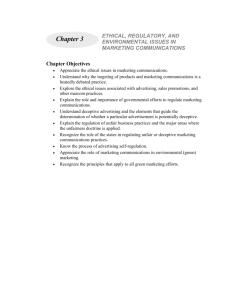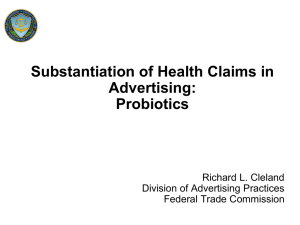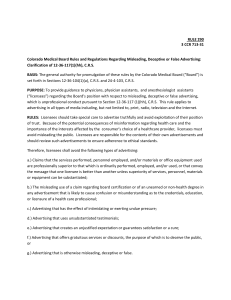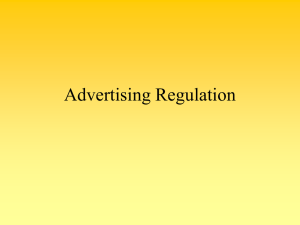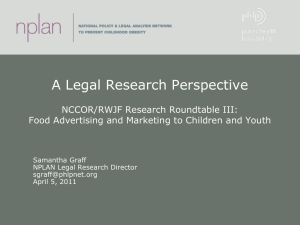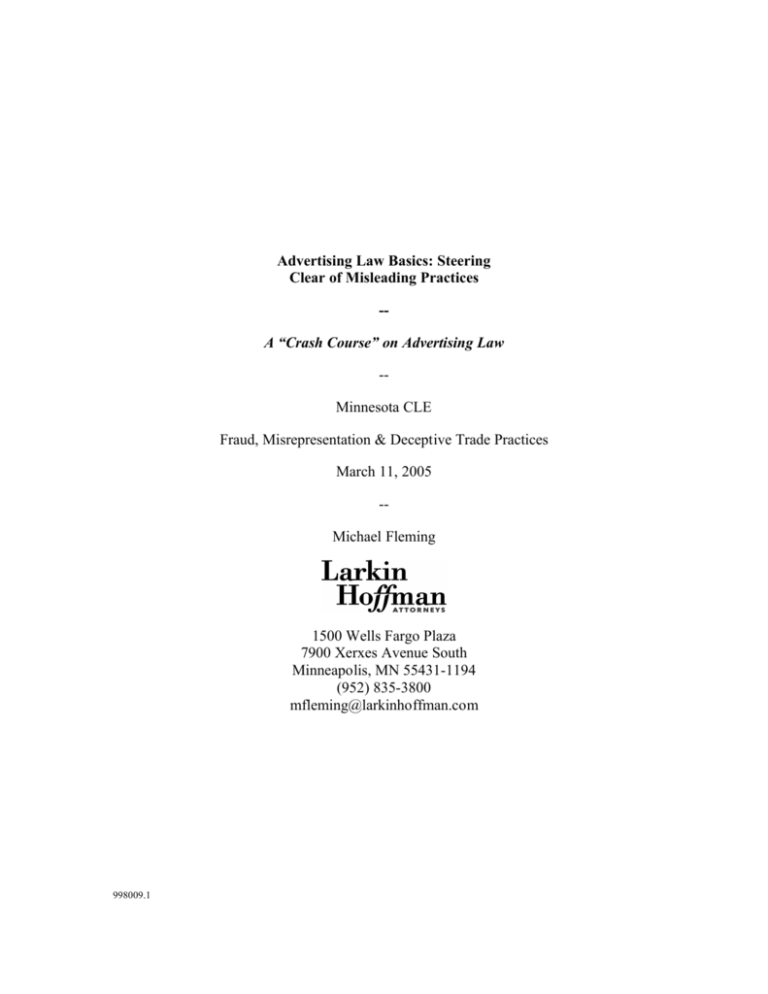
Advertising Law Basics: Steering
Clear of Misleading Practices
-A “Crash Course” on Advertising Law
-Minnesota CLE
Fraud, Misrepresentation & Deceptive Trade Practices
March 11, 2005
-Michael Fleming
1500 Wells Fargo Plaza
7900 Xerxes Avenue South
Minneapolis, MN 55431-1194
(952) 835-3800
mfleming@larkinhoffman.com
998009.1
Table of Contents
1.
Road Map to the Crash Course................................................................................ 1
(a)
A Few Quick Rules of Thumb ......................................................................... 1
(b)
Where Can I Get a Little Law.......................................................................... 1
2.
3.
4.
Quick Rules of Thumb ............................................................................................ 1
(a)
Be Fair and Don’t Mislead .............................................................................. 1
(b)
Remember the Two Most Important Words In Advertising Law ...................... 2
(c)
Disclaim Where Necessary.............................................................................. 3
(d)
Beware the Puffery Defense ............................................................................ 3
(e)
Special Types of Claims Get Extra Scrutiny .................................................... 4
(f)
Intellectual Property Must be Respected .......................................................... 6
Sources of Law ....................................................................................................... 7
(a)
Federal ............................................................................................................ 7
(b)
State................................................................................................................ 8
(c)
Interpreting Section 5 is the Real Game........................................................... 8
Summary ................................................................................................................ 9
© 2005 Larkin Hoffman Daly & Lindgren LLP. All rights reserved.
Disclaimer: These materials are intended to provide current information about the
subject matter covered, and are designed to assist attorneys maintain their professional
competence. These materials are distributed with the understanding that neither the
author nor Larkin Hoffman Daly & Lindgren LLP are rendering any legal, accounting or
any other professional advice. Attorneys using these materials in dealing with a specific
client’s legal matter should also research original material and fully quoted sources of
authority.
998009.1
Advertising Law Basics: Steering
Clear of Misleading Practices
-A “Crash Course” on Advertising LawTO UPDATE, PRESS F9
by Michael Fleming
1. Road Map to the Crash Course
(a) A Few Quick Rules of Thumb
A simple set of rules that one can use to analyze nearly any advertisement for potential
consumer-law pitfalls.
(b) Where Can I Get a Little Law
A short set of sources of basic advertising law, primarily focusing on the federal realm.
2. Quick Rules of Thumb
(a) Be Fair and Don’t Mislead
Consider that the FTC, as well as states’ enforcement agencies, will apply two standards
to their inquiry on whether a consumer was harmed by an advertiser’s acts – ‘unfair’ and
‘deceptive’. Each of those will enter into the question of whether an advertisement was
truthful.1
Unfair acts are the tougher of the two to spot, since they may be made in the context of a
completely truthful statement. However, where consumer injury is (or could reasonably
be) great, where consumers are encouraged to perform illegal acts, or where consumers
could not reasonably be expected to find necessary additional information, the statement
may be deemed as unfair.
Deceptive acts can be easier to spot. Obviously, flat-out lying of a material fact would be
deemed as a deceptive act. However, deceptive acts can also include the withholding of a
material fact, even where the rest of the statements in the presentation are literally true.
1
“In interpreting Section 5 of the Act, the Commission has determined that a representation, omission or
practice is deceptive if it is likely to:
·
mislead consumers; and
·
affect consumers' behavior or decisions about the product or service.
In addition, an act or practice is unfair if the injury it causes, or is likely to cause, is:
·
substantial;
·
not outweighed by other benefits; and
·
not reasonably avoidable.”
Advertising and Marketing on the Internet: Rules of the Road as seen at
(http://www.ftc.gov/bcp/conline/pubs/buspubs/ruleroad.htm).
Advertising Law Basics: Steering Clear of Misleading Practices
For example, failing to state that a test involving stopping distance was performed on a
dry street, while simultaneously showing graphics of a wet street (while never actually
saying that the tests took place on such a street), could be deemed deceptive.
(b) Remember the Two Most Important Words In Advertising Law
(i) Word # 1 is Claim
Claims are the raw material of an advertisement. Anything in the ad that is a statement
comprising a Fact that may be proven (or disproved) is a claim.
Claims are not just the parts that a layperson would think of as a claim (“nine out of ten
doctors say…”). Claims are any statement in the advertisement that may be subject to
proof: retail prices, availability of product, statements of results such as attractiveness to
the opposite gender, colors, thickness of stew based on appearance in a picture, ease of
preparation, and so on.
Advertising analysis is essentially the art of decompiling an advertisement into its
constituent claims. Once the claims are spotted, one then determines whether each of
those claims can stand alone as a truthful statement, and also whether the claims in the
entire ad, when put together, continue to be truthful (i.e., not unfair or misleading). If any
of those tests fail, then the ad must go back to be reworked.
(ii) WORD # 2 is Substantiate
Substantiation is nothing more than the proof of the truthfulness of a claim. In many
cases, it means a written record – the ‘file copy’ of the factual study. In other cases, an
advertiser’s existing business records might serve as the source of substantiation – there
is probably no need to create a separate database of retail prices just for the advertising
substantiation if the retailer’s existing price database will keep adequate and accurate
records (including historical pricing records!). In rare cases, claims might be allowed to
be substantiated by their own physical evidence – a claim that a hotel is located in Duluth
is probably adequately substantiated by the building itself (presuming it is in Duluth!).
For each (and every!) claim in an advertisement, the advertiser must have substantiation
on hand prior to publication (or broadcasting, whatever verb may be appropriate to the
medium). Post-publication substantiation is not good enough, since the advertiser must
be able to show it knew of the truthfulness at the time the message was delivered. So, the
advertiser’s substantiation files (or other supporting records) should be set up not only to
show the proof-of-claim itself, but also the time the proof was put into the files.
There may be some judgment applied to the depth of the substantiation, largely
depending on the materiality of the underlying claim as well as the perceived credibility
of the claim and the potential for consumer harm that arises from the claim.
2
Advertising Law Basics: Steering Clear of Misleading Practices
(c) Disclaim Where Necessary
A ‘disclaimer’ – in advertising law – is a statement that accompanies a claim in order to
explain. A disclaimer is used where the initial claim might be deemed unfair or deceptive
in the absence of further explanation. For example, a broad claim of “Lose Ten Pounds
in Three Weeks!” might be disclaimed by an accompanying statement of “Presumes No
Food will be eaten in first two weeks.”
However, one cannot use a disclaimer to overcome an untruth. In short, disclaimers do
not trump lies. A disclaimer should be thought of as adding additional information to a
claim, not as a means to reverse what had been stated in the claim.
One of the rules of disclaiming is that it should be done conspicuously enough to have an
effect on the consumer. In print or Web media, that will typically require physical
proximity between the claim and its accompanying disclaimer, or at the least a very
prominent pointer near the claim to guide the reader to the disclaimer – such as the
typical asterisk next to a claim of “Low Interest” which leads to a long disclaimer
describing the conditions of that interest rate offer. In broadcast, disclaimers will
typically need to be proximate in time to the claim, and may need to be verbal as well as
written depending on the type of claim. In general, level of conspicuousness is going to
be dependent on factors such as the potential for consumer confusion over a material fact
or the potential for consumer injury arising from a deception.
(d) Beware the Puffery Defense
The favorite fall-back of the 1L in the warranty section of Contracts 101 – puffery –
remains a popular excuse in advertising law as well. However, the idea of puffery – at its
core, a sanctioned excuse to tell a fib – is quite limited in application. It only applies
where any and all reasonable persons would know that the statement is obviously not
intended to be stated for its truth. While the classic example of the old Joe Isuzu
character – with the subtitles “He’s Lying” – are an obvious joke on the puffery defense,
there are actually very few examples where a puffery truly applies, since one should not
overestimate the likelihood that all reasonable consumers will be in on the joke.
For example, Pepsi was hit some years ago with a suit by a consumer claiming that
Pepsi’s “Point” program was misleading, when Pepsi advertised that one could
“purchase” a Harrier military jet with a mere 7 million points from screw-caps. When the
consumer actually turned in the 7 million points (or, actually, the stated equivalent of
$700,000, which was Pepsi’s price to buy points where one came up a bit short) and
claimed his Harrier, Pepsi argued that the advertisement was an obvious joke – puffery.
The consumer disagreed, and pursued action that was ultimately heard in Federal District
Court in New York. Pepsi eventually prevailed on summary judgment,2 when the judge
observed that since a Harrier costs about $23 million, an objective, reasonable person
would conclude that purchasing it for $700,000 "is a deal too good to be true." All well
2
Leonard v. Pepsico Inc., No. 96 Civ. 9069(KMW) (SD NY, Aug. 5, 1999).
3
Advertising Law Basics: Steering Clear of Misleading Practices
and good for Pepsi in the long-run, but the short-run was certainly quite expensive for
Pepsi, and probably not worth the joke benefit the advertisement led to. In this case, the
consumer’s acts by themselves probably hurt his case, since it seemed that he clearly
knew that this was a joke and took pains to carefully set Pepsi up for the claim, and the
consumer was ultimately not injured (very much…) since he obtained a refund of his
$700,000.
Puffery has become even more complex as the media world expands its channels. While
“the worlds biggest bookstore” might be an obvious puffery on a physical sign on a
storefront, it has been deemed actionably misleading where an Internet-only bookstore,
which clearly was not the “biggest” in any sense of the word, took on that phrase for its
tagline.3 The fact-finder felt that a consumer on the Internet would not necessarily have
the clues that a consumer on the street looking at the store might have – on the Internet,
every store can look like the biggest store.4
Note that subjective, unprovable statements are not necessarily puffery – puffery applies
where the statement could literally be proven (or disproved). “Pretty” or “prettier” are
probably in the realm of subjective, so one can likely say that one’s car is a pretty car
without need for proof (unless science should come up with a way to look into the eyes of
all the beholders). However, “prettiest” is potentially provable, since it implies a
provable fact – and one better be able to show how that determination was made, such as
the basis of what is pretty or not pretty. (Good luck…) Moreover, statements that
involve an objective statement about a subjective belief, such as “most Minnesotans think
our lakeshore is pretty” would certainly be subject to proof, since that implies that a
statistically valid consumer survey was taken to determine that claim’s truth.
(e) Special Types of Claims Get Extra Scrutiny
(i) Pricing
When there are statements using the word SALE or LOWER PRICES (comparing
today’s price to the same advertiser’s own prior prices – contrast this with the
comparative advertising claims discussed below), the advertiser’s need for substantiation
will require the obvious historical perspective. In addition, the advertiser will be held to
certain standards, set by regulatory agencies such as the FTC, as to how long a prior price
must have been offered before the word SALE can be justified.
Another pricing buzz-word that will attract attention is FREE. In essence, one can only
use the word FREE when the statement is literally true. A so-called FREE cookie that
3
See http://www.nacs.org/newsroom/news/101700-nad-ruling.asp (viewed March 7, 2005). The online
seller ultimately decided to drop the tagline after the NAD issued its opinion that the phrase was subject to
proof and not puffery.
4
A tribute to the famous New Yorker cartoon with the caption “On the Internet, nobody knows you’re a
dog.”
4
Advertising Law Basics: Steering Clear of Misleading Practices
can only be obtained when one buys the lunch first is not FREE – it is a cookie at no
additional charge when you buy a lunch.
After-rebate price claims are targeted heavily in some states – Connecticut for example
has essentially banned the practice of after-rebate price claims.
(ii) Testimonials - No Excuse That He Said It!
A testimonial – whether by a celebrity or by the average Joe or Jane – is held to two
levels of substantiation scrutiny. First, if the speaker of the testimonial is saying the
statement because it is scripted by the advertiser (whether or not for compensation), then
the advertisement must make clear that the statement is not the actual thought or belief of
the speaker.
Second, even if the speaker is truthfully speaking his or her own beliefs, the advertiser
must equally substantiate the veracity of the underlying claim as if the advertiser has
made the statement itself. If the testimonial from the man-on-the-street is that such-andsuch bread cures the common cold, even if that speaker truly believes that to be true, the
advertiser who chooses to broadcast that statement will be held to prove that his Suchand-Such brand bread cures the common cold.
(iii)Comparison to Competitor
Comparative advertising is considered proper in this country, provided that it does not
mislead the consumer. Trademark law (which is, at its heart, a consumer protection law
since it looks to prevent false claims of relationship), largely allows for mentioning a
competitor’s products and trademarks provided that the ad makes clear that the
trademarks are owned by the competitor and not the advertiser. From an ad law
perspective, the comparison must not be deceptive or unfair – apples to apples in all
senses. A price comparison should be taken at the same level of retail at the same time –
it is not fair to compare a manufacturer’s list price against a discount retailer’s price for a
competing product, at least where the other company’s products are also available in that
same discount store. Claiming that one bottle of Product X is as good as two bottle of
Product Y (and implying that one spends half as much) is unfair if the advertiser fails to
mention that the dilution of X is half that of Y, and the price of X is twice that of Y –
essentially both products deliver the same amount of active ingredient at the same price.
Note that many other countries ban or greatly limit comparative advertising. In fact,
many other claims that are permitted in the USA, such as SALE, are prohibited or
restricted outside of the USA – in Europe in particular. So, advertisers who are directing
their ads to non-USA areas should seek specialized advice, or simply avoid many of these
kinds of claims where the ad is meant for a worldwide audience.
(iv)Health
It goes without saying that any health-related claim – whether it be weight-loss, painrelief, or enhancements to one’s love life – will be scrutinized to the greatest extent. As
we all know, there are particular standards where drugs are advertised, including rules on
5
Advertising Law Basics: Steering Clear of Misleading Practices
the publications of disclaimers on possible side-effects and the like. These types of
claims will usually require specialized expertise, since there are rules that come from
FTC, the FDA, potentially other federal agencies, as well as a slew of state agencies.
(v) Get Rich
There is no such thing as a free lunch, and most claims involving great potential to get
rich will usually require extensive disclaimers (if they can even be disclaimed in the first
place). Typically, since getting money will require some element of risk, the risks of the
plan to get money must be a prominent part of the advertisement, and the methods of
providing such disclaimers will be particularly important where the chance of consumer
injury is greater (such as marketing speculative investments to potentially unsophisticated
consumers).
(vi)Directed to Kids
While the FTC ultimately backed off its attempts of the 70’s to create a specific legal
framework for advertisements directed to children,5 the area remains controversial even
under existing advertising laws. Consider that children are going to be more easily
injured by a falsehood, or that they might be less apt to ferret out a puffery, and it
becomes clear that advertisers directing towards children have a harder job in front of
them. The Better Business Bureau has a sub-group specifically targeted to influencing
advertising directed to children.6
(vii)
Extra-Long Hot Dogs
Legend has it that the state of Minnesota has regulated claims concerning the length of
hot dogs available at the Minnesota State Fair – hence the Almost-A-Foot-Long Hot Dog
booths at the Great Get Together. Interested wiener vendors would be wise to inquire of
the fair’s concession departments for specific rules.
(f) Intellectual Property Must be Respected
While not strictly a matter of consumer protection, an advertiser must still ensure that the
advertisement itself is not an infringement or violation of others’ intellectual property
rights. Photographs have copyrights, and so clearances, licenses and ownership should
be analyzed.
Trademark rights should be respected. Sometimes there will be a contractual license
from a third party to use that party’s trademarks, and there will be corresponding
obligations with that license on how the marks should be used. In other instances, the
advertiser may have some right to use the other’s marks without express permission (such
5
There have been some less-broad attempts since then, primarily the Children’s Online Privacy and
Protection Act (COPPA), which regulates the use of online-gathered marketing information.
6
See http://www.caru.org/ for further information.
6
Advertising Law Basics: Steering Clear of Misleading Practices
as under comparative advertising rules), but even then the marks should be respected –
use in the normal color scheme, do not mar or alter the mark, and make clear that the
marks are owned by others.
Individual people who are portrayed in graphics in an ad (photograph or otherwise)
should give clearances before their images are used. This goes without saying when
using professional models and actors – although be careful to analyze the clearances if
the advertiser might want to reuse those images in other contexts or different ads, since
many clearances are limited in time or uses. One of the biggest potholes that may strike
is thinking that one’s own employees are fair game without need to obtain permission.
But, the right of publicity (or privacy) derives independently from copyright7 and other
doctrines that have work-for-hire rules. While employees might be happy about the use
of their pictures while they remain loyal employees, it is usually the post-employment
period where the then ex-employee is less pleased about it all. So, employers should get
those clearances even from their own employees, and obtain them when the pictures are
being taken, not when things look dark.
Exhibit A to this document is a form of release designed primarily for the employee
situation, although it might apply to any clearance where the grant is intended to be for
no money.
3. Sources of Law
The raw sources of advertising law are surprisingly few – largely the consumer protection
laws known as the fair trade acts at the federal and state level. Those acts are, on their
face, are quite short. However, the interpretations and applications of those short
statements of law can fill volumes.
(a) Federal
The Federal Trade Commission is charged with enforcing the Fair Trade Act. Section 5
of the Act8 contains the Act’s single most important sentence: “Unfair methods of
competition in or affecting commerce, and unfair or deceptive acts or practices in or
affecting commerce, are hereby declared unlawful.” From this one sentence springs,
essentially, the entire body of advertising law.
While the idea of ‘commerce’ (and its constitutional implications) is an important one
(best left for another program), the phrase to focus on here is “unfair or deceptive acts or
practices.”
7
See Lake v. Wal-Mart Stores, Inc., 581 NW.2d 231 (Minn. 1998) (recognizing privacy and publicity
claims as common-law actions).
8
15 U.S.C. § 45.
7
Advertising Law Basics: Steering Clear of Misleading Practices
(b) State
The states have, more or less, all implemented so-called “little FTC Acts” – all of them
have language similar to FTC Act § 5, although few are as succinct as the federal Act. In
Minnesota, we have a statute specifically aimed at False Advertising.9 In short, it
prohibits an advertisement “which advertisement contains any material assertion,
representation, or statement of fact which is untrue, deceptive, or misleading.” The
statute’s accompanying sections give rules concerning specific topics, such as a goingout-of-business sale, although as a whole they would not provide anywhere near a
complete palette of rules for the advertising practitioner, and would need to be
supplemented greatly by the general rules from the federal system. The Minnesota
statute, similar to many other state statutes, is enforced by the attorney general’s office
(including its county attorney system), 10 although Minnesota also allows for some private
causes of action for false advertising violations under the so-called private attorney
general statute.11
(c) Interpreting Section 5 is the Real Game
The brevity of Section 5 is both a blessing and a bane. There is some case law, although
much of the “law” is made in private arbitration arenas. Thus, looking for interpretive
guidance can be overwhelming, particularly since there will rarely be a black-letter rule
exactly on point. Practitioners typically bring a combination of experience and common
sense, as well as a strong backbone to deal with marketing-types who insist that their
particular statement should be an exception to the rules.
The FTC itself remains a prime source of interpretative guidance to Section 5, and most
of the time following federal guidance will also lead to state compliance. The agency has
published many “Guides” to its interpretations of ad law, and many of those are
published in Chapter 16 of the Code of Federal Regulations.12 The FTC also has a fairly
9
Minn. Stat. § 325F.67.
10
Id.
11
Minn. Stat. § 8.31, subd. 3a.
12
Some examples of Guide titles the FTC has issued:
(1)
(2)
(3)
(4)
(5)
(6)
(7)
(8)
(9)
Dietary Supplements: An Advertising Guide for Industry
Guide Concerning the Use of Endorsements and Testimonials
Guide Concerning the Use of the Word "Free"
Guides Against Bait Advertising
Guides Against Deceptive Pricing
Guides for the Jewelry, Precious Metals, and Pewter Industries
Guides for the Household Furniture Industry
Guides for Private Vocational and Distance Education Schools
Jewelry Guides and Information
8
Advertising Law Basics: Steering Clear of Misleading Practices
well-organized Web site, and much of it is intended for businesses and advertisers. Many
of the FTC’s non-Guide documents concerning advertising are published on the Web site,
and many make for interesting reading.13
Publishers, and particularly broadcasters, who all have an interest in maintaining their
own reputations, bank accounts, and in some instances licenses, will typically issue their
own guides as to what is acceptable or not within their own pages or broadcasts. The art
of broadcasting clearance – and the back and forth of negotiation – is beyond the scope of
this document, but it is often the primary means for many advertisers to ensure
compliance at a legal level as well.
Many ad law “decisions” are, in fact, the results of a private, non-binding arbitration
system – the most relevant of which is the Better Business Bureau’s National Advertising
Division.14 The system is voluntary on the part of complainants and targets, and the
arbitrators can issue only non-binding advice on whether and how the target should alter
its practices. That said, the NAD’s decisions are usually well-detailed, offer thoughts on
the subtleties that will often be missing in other authorities, and are well indexed (albeit
at a significant cost to obtain). The NAD’s power lies in its persuasiveness and respect,
particularly since the FTC will often treat advertisers who flout NAD decisions as prime
targets for FTC enforcement actions. In general, the traditional advertising industry has
managed to be one of the best examples of industry self-enforcement (although selfenforcement works best where there is a policeman standing in the back of the room). It
remains to be seen, however, if that tradition will continue as the new media expand the
number of channels, advertisers and players in this arena.
4. Summary
The 80/20 rule probably applies to advertising practice just as much as anything else.
Non-advertising practitioners should not shy away from advising clients on obvious
problems in advertisements. A simple system of review, coupled with the basic groundrules discussed above, should spot most of the major concerns and may be good enough
for many run-of-the-mill advertisements – leaving specialists to look at the exceptional
matters like drug advertising.
When presented with an ad for clearance, break down the claims within – if necessary, jot
them down one by one. Do not forget the implied claims from graphics – pictures really
are worth more than a thousand words, and the things a consumer might reasonably
conclude from a picture in an ad are just as much a claim as the words.
(10)
Joint FTC/FCC guides on Long Distance Advertising
(11)
Refractive Eye Surgery Advertising: Guidance for Marketers
13
http://www.ftc.gov/bcp/guides/guides.htm
14
http://www.nadreview.org/
9
Advertising Law Basics: Steering Clear of Misleading Practices
With the claims in hand, look to each one for whether it has been proven in advance by
the advertiser. Make sure that the advertiser has a system in place to prove up prepublication substantiation, and demand to see at least some of that substantiation so that it
is apparent that they system is adequate. Obviously, some claims will demand more
scrutiny by the lawyer than others, and judgment on how far to take a demand for proof is
one of the hardest things to learn – err on the side of caution.
Finally, always remember the primary focus of advertising law – despite all the rules of
thumb, subject-matter-specific interpretations, and the wealth of subtleties, in the end it
all boils down to a few simple words – Be fair, do not mislead, do not seek to deceive. If
those thoughts are always in the back of the mind, most of the rest will be much easier to
interpret.
10
Exhibit A
Release for Marketing and Advertising Assets
I am a contractor performing services as a photographic model for the benefit of Company, a Minnesota corporation
(“Company”), as a subcontractor or employee of a photographer that is directly performing services for Company under a
separate agreement (the “Engagement”). The photographer’s name is _____________________________ (“Photographer”).
I have been asked to make the following “Release” as a condition of my engagement. In consideration of my engagement by
Photographer to perform such services, I agree that all information set forth in this Release is true and correct and also agree to
the following:
1. I hereby grant to Company the unrestricted right and
permission to copyright and use, re-use, publish, and
republish photographic portraits or pictures of me or in
which I may be included, taken by Photographer under the
Engagement, intact or in part, composite or distorted in
character or form, without restriction as to changes or
transformations in conjunction with my own or a fictitious
name, or reproduction hereof in color or otherwise, made
through any and all media now or hereafter known for
illustration, art, promotion, advertising, trade, or any other
purpose whatsoever. I also permit the use of any printed
material, broadcast, electronic or any other form of
presentation of such photographs, in any media now
known or that may be invented, created in connection with
the Engagement.
2. I hereby relinquish any right that I may have to examine
or approve the completed product or products or the
advertising copy or other media matter that may be used in
conjunction therewith or the use to which it may be
applied.
3. I hereby release, discharge and agree to save harmless
Photographer and Company, and each of their heirs, legal
representatives or assigns, and all persons functioning
under their permission or authority, or those for whom
they are functioning, from any liability by virtue of any
blurring, distortion, alteration, optical illusion, or use in
composite form whether intentional or otherwise, that may
occur or be produced in the taking of photographs through
the Engagement or in any subsequent processing thereof,
as well as any publication thereof, including without
limitation any claims for libel or invasion of privacy.
Signature
Printed Name
CURRENT MAILING ADDRESS:
4. The rights that I have granted to Company also extend
to Company’s subsidiary and parent corporations,
licensees, successors and assigns (hereafter collectively
Company), and all persons acting with their permission or
authority. Company may transfer, assign or sublicense any
of the rights, in whole or in part, and Company does not
need to give me notice of or further compensation for
doing such.
5. I understand that my grants and releases set forth in this
Release will last forever in duration and are irrevocable.
6. The laws of the State of Minnesota shall govern this
Release. This Release is between myself and
Photographer. Company is a third party beneficiary of this
Release. The provisions of this Release are intended to be
enforced to the fullest extent allowable by law. If any
provision is found invalid or unenforceable, the remainder
of this Release shall remain valid and enforceable
according to its terms and any provision found invalid or
unenforceable shall be deemed modified to the extent
necessary to make it valid and enforceable. I acknowledge
and agree that I am not an employee of Company, that I
am not eligible to receive any employment benefits from
Company, and that I shall look solely to Photographer for
any compensation that may be due to me for work I have
performed and/or for the grants and releases set forth in
this Release. I hereby affirm that I am over the age of 18
and have the right to contract in my own name. I HAVE
READ THIS RELEASE PRIOR TO ITS EXECUTION; AND I FULLY
UNDERSTAND ITS CONTENTS. This Release shall be binding
upon me and my heirs, legal representatives and assigns.
Date

